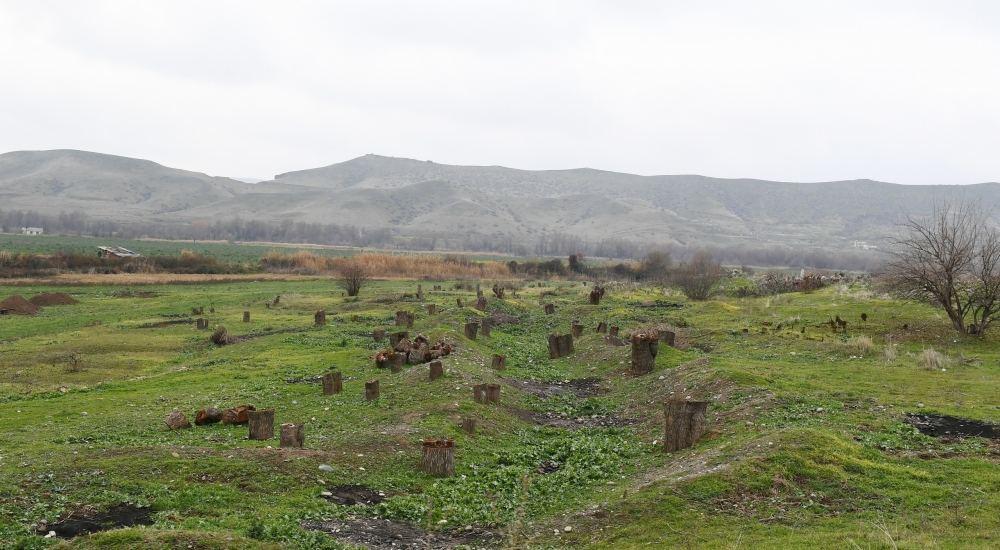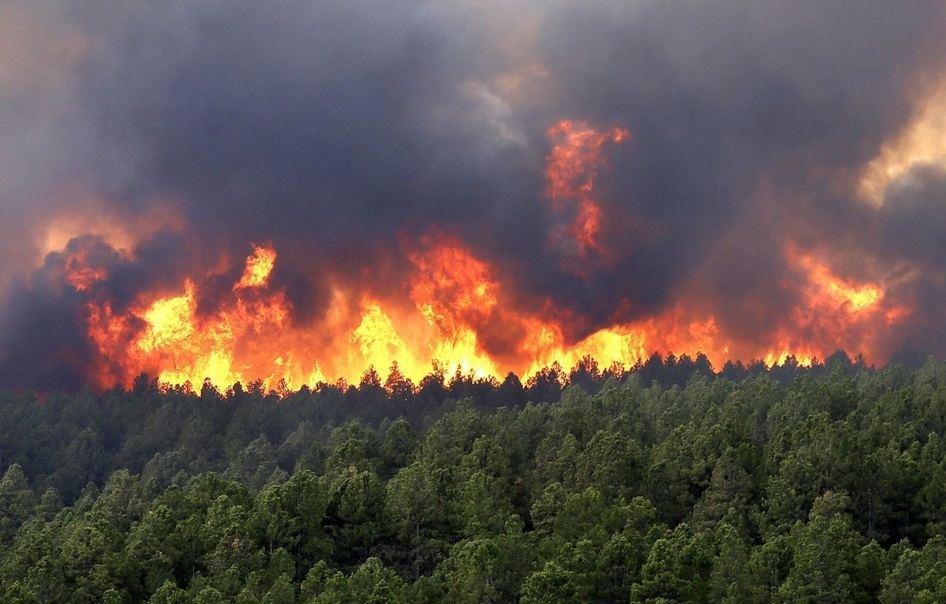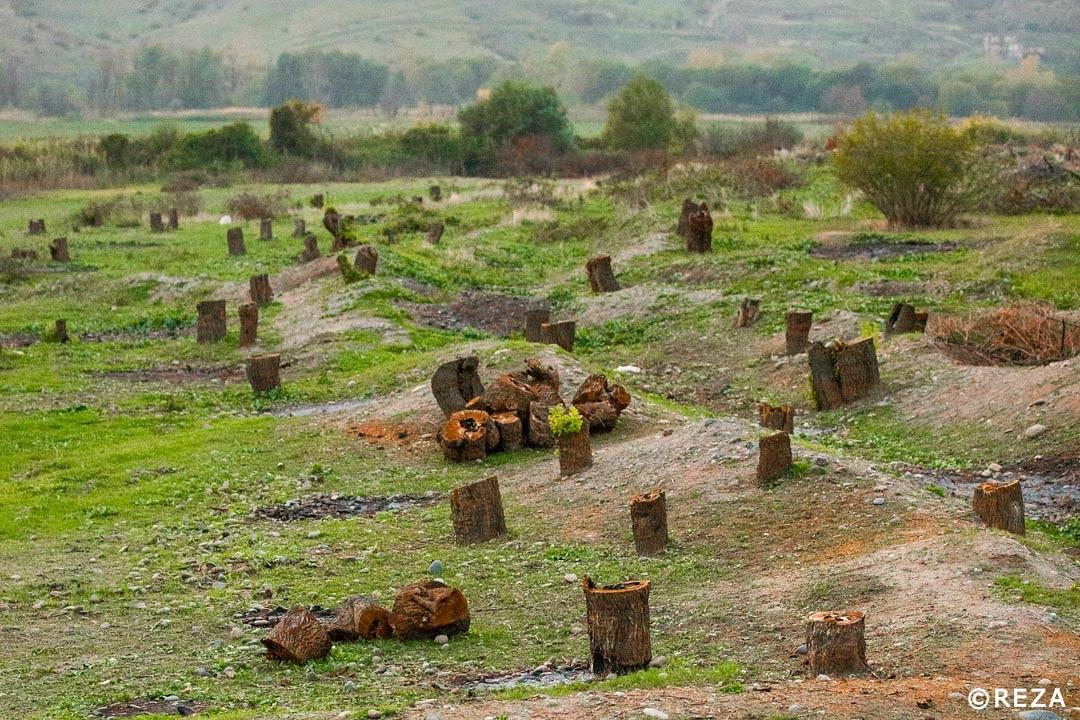Armenia's ecological terror against Azerbaijan during three-decade occupation

By Vafa Ismayilova
Armenia’s three-decade occupation of Azerbaijani territories extensively damaged the ecosystem, wildlife and natural resources in and around the occupied Nagorno-Karabakh region.
Armenians also resorted to large-scale acts of ecological terror in regions they had to leave under the trilateral November peace deal that stipulated the return of Azerbaijan’s occupied territories.
Ecological terror after the peace deal
Deeply frustrated by heavy losses and failure during the Second Karabakh War that saw Azerbaijan liberate its occupied territories, Armenians destroyed almost everything in the lands they had been occupying. The joint peace deal signed on November 10, stipulated that Armenians leave occupied regions Kalbajar by 15 November (later extended to 25 November), Aghdam by 20 November and Lachin by 1 December. Azerbaijan agreed to delay the takeover of Kalbajar until November 25 after a request from Armenia.
Large-scale ecological terror was especially observed during the handover of Kalbajar region to Azerbaijan that was stipulated by the November agreement. Kalbajar's handover was also accompanied by grave deforestation as the region’s Armenian residents were cutting the trees before leaving. The vast amount of trees were chopped and transported from Kalbajar on large trucks as Armenians left the Armenian-occupied region. Videos have also emerged of decapitated horses and donkey scattered across Kalbajar. Furthermore, Armenians have been setting fire to their homes to prevent them from falling into Azerbaijanis’ hands.
Armenian forces also set deliberate fire at Shusha forest with the total area of 8,526 hectares. Experts believe that the burning of the trees was calculated to stop Azerbaijan’s use of drones in its liberation of Shusha city. Azerbaijan liberated Shusha on November 8 after 28 years of Armenia’s control over the city. Shusha was Karabakh’s second-largest city with the Azerbaijani-majority population.
Experts note that the total forest area under Armenia's occupation was 247,352 hectares; about 13,197 hectares of these are of particular importance.
“More than 460 wild plants and shrubs grow in these forested areas. Of these, 70 are endemic and do not grow naturally anywhere else in the world. In Kalbajar region, 968 hectares of trees included on the IUCN [International Union for Conservation of Nature] Red List were also cut down and sold abroad,” expert Naghi Ahmadov said.
Officials urge end to Armenian eco-terror
Commenting on the situation, Azerbaijani presidential aide Hikmat Hajiyev urged an end to Armenia’s ecological terror.
“Armenians are damaging the environment and civilian objects. Environmental damage, ecological terror must be prevented,” Hajiyev said.
Deputy Ecology and Natural Resources Minister Vugar Karimov strongly condemned the large-scale ecological terror in Kalbajar during the region’s handover.
He described as serious environmental crimes the destruction of Azerbaijan’s flora and fauna by Armenia, especially, the cutting down of more than 2,000-years-old plane trees in Jabrayil, Zangilan, Gubadli, and other liberated Azerbaijani territories, the burning of the Topkhana forest around Shusha with the banned white phosphorus, and also the felling of trees, arson attacks on forests and the intentional damage to the environment in Kalbajar.
“We again witnessed this barbarism in the photos and videos that were spread in the media outlets yesterday [15 November]. The environmental crimes committed by Armenia for many years are also evidenced by the Azercosmos satellite images. Moreover, the genocide against nature, biodiversity of the region committed by Armenia has been reflected in the preliminary results of monitoring carried out by the Ecology Ministry's employees," he said.
He added that the available facts had been submitted to the secretariats of the relevant international agencies. International observation and assessment teams will be invited to Azerbaijan to record these facts and assess the damage. He also pointed out that work is already underway to restore the ecological balance on the liberated territories.
In her appeal to numerous international organizations, Human Rights Commissioner Sabina Aliyeva said that as a result of Armenia's thirty-year military aggression, nature, biological diversity, water reservoirs of Azerbaijan, as well as the environment of the areas under the occupation have been seriously affected, which consequently, caused severe damage to the environment.
The rights commissioner added that the destruction of a unique ecosystem with a total area of more than 8,000 hectares, consisting of valuable and perennial dense forests of oak, juniper, beech, hornbeam, pine, ash, and walnut, is the hardest blow to endemic biodiversity. Hence, this means serious violations of the international treaties in relation to the protection of the environment, including the UN Convention on the Prohibition of military or any other hostile use of environmental modification techniques, to which Armenia is also a party.
According to experts’ opinion, forest fires caused by white phosphorus bombs cannot be extinguished and putting out such fires naturally is also not possible, and so, such fires last long. This is environmental terrorism, Aliyeva said.
She added that as a result of military operations and the use of internationally prohibited weapons by Armenian armed forces, not merely the natural environment has been exposed to physical and chemical pollution, but various species of rare plants and animals, flora and fauna biodiversity had been destroyed. Chemical pollution of freshwater sources resulted in a violation of the self-regulation process in rivers and lakes, as a result of which water ponds become more hazardous.
Aliyeva stressed that in 2006 the UN General Assembly Resolution A/RES/60/285 on “The situation in the occupied territories of Azerbaijan” had also called for an assessment of and counteraction to short and long-term environmental degradation of the region.
In 2016, the Parliamentary Assembly of the Council of Europe adopted Resolution No.2085 titled “Inhabitants of frontier regions of Azerbaijan are deliberately deprived of water”, demanding the immediate withdrawal of Armenian armed forces from the concerned region and allowing access by independent engineers and hydrologists to carry out a detailed survey on the spot.
Eco-terror during the 30-year occupation
Speaking recently about vandalism and destruction carried out in Azerbaijan’s lands in the past three decades, President Ilham Aliyev stressed that Armenia cut off Azerbaijan’s water for 30 years and left 100,000 hectares of land without water even though both Sarsang and Sugovushan reservoirs were built at National Leader Heydar Aliyev’s initiative.
As noted by the president, the water problem has also been at the heart of Armenia’s ecological terror during the Nagorno-Karabakh conflict. This issue has been painful for Azerbaijan as the country has been experiencing water shortage and drought problem in recent years.
The 560-million-cubic-meter Sarsang reservoir has been under Armenian occupation since the end of the war in 1994. Azerbaijan’s loss of access to Sarsang has deprived the country’s six regions surrounding Nagorno-Karabakh of drinking and irrigation water. The authorities in separatist Nagorno-Karabakh republic blocked the Sarsang reservoir from flowing to the Azerbaijani regions during summer while opening floodgates to these regions in winter.
In 2015, the Parliamentary Assembly of the Council of Europe (PACE) highlighted the environmental problems related to the maintenance of the Sarsang reservoir, namely, lack of regular maintenance work and its danger to the whole border region. PACE emphasized that the “state of disrepair of the Sarsang dam could result in a major disaster with great loss of human life and possibly a fresh humanitarian crisis”.
Nagorno-Karabakh’s separatist authorities have been refusing to cooperate with PACE over the assessment of Sarsang reservoir’s condition and the condition of the reservoir remains unknown.
There are concerns over the management and the future of the reservoir. The former separatist leader of Nagorno-Karabakh Arayik Harutyunyan in 2018 announced the launch of a 100-million-dollar project on the construction of a canal to pump water from the Sarsang reservoir and to build three more reservoirs for the irrigation of 10,000 hectares of land. Such reckless expansion of Sarsang reservoir without any technical and environmental considerations could lead to a disaster. According to experts’ estimates, the possible damage on Sarsang reservoir during the outside interference would lead to ecological calamities and the flooding in the 930 hectares that the reservoir covers as well as Azerbaijan’s four regions Tartar, Barda, Aghdam and Aghjabadi.
For over 27 years, Sarsang water reservoir’s dam has been eroded due to neglect. Any further mishandling or military provocation could lead to the collapse of the dam and endanger the entire region.
Armenians have also been looting Azerbaijan’s minerals on occupied territories. Some 155 precious metal deposits, including five gold deposits in Azerbaijan’s occupied territories, have been recklessly exploited without considering ecological ramifications.
In her above-mentioned appeal, Rights Commissioner Sabina Aliyeva noted that "within this period of time, natural resources in the occupied areas of Azerbaijan have been plundered, 163 mineral resources deposits, including gold, mercury, copper, lead, zinc, coal and others, also forest cover, rare trees have been subjected to illegal exploitation by Armenia".
With regard to all abovementioned facts, Aliyeva called on international organizations, including all stakeholders acting for ecology and environmental protection to take all feasible measures to stop and prevent the environmental terrorism committed by Armenia and establish international legal responsibility of Armenia.
All aforesaid factors are part of Armenia’s war crimes committed during the Nagorno-Karabakh conflict and amount to the ecological disaster in the South Caucasus region. Unfortunately, they have not received an adequate reaction from the international institutions and NGOs that deal with environmental issues.
--
Follow us on Twitter @AzerNewsAz
Here we are to serve you with news right now. It does not cost much, but worth your attention.
Choose to support open, independent, quality journalism and subscribe on a monthly basis.
By subscribing to our online newspaper, you can have full digital access to all news, analysis, and much more.
You can also follow AzerNEWS on Twitter @AzerNewsAz or Facebook @AzerNewsNewspaper
Thank you!


